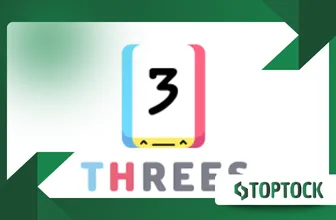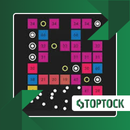Threes: Slide Numbers Wisely to Score Big

Threes is a number-matching puzzle game that captured global attention with its charm and intellectual depth.
Anúncios
Developed by Sirvo, the game’s premise involves merging tiles on a 4 x 4 grid.
The fundamental rule states that tiles with the same number, or the initial 1 and 2 tiles (which combine to form 3), merge when slid into each other. This creates a tile of their sum.
The core of the challenge lies in its elegance: every swipe moves all tiles on the board, and a new tile always enters the grid from the opposite direction.
This constant flux demands foresight, tactical planning, and an almost chess-like anticipation of future board states.
Anúncios
Why does this game, released years ago, still dominate conversations among puzzle aficionados in 2025?
It’s the perfect blend of simplicity and brutal complexity, making it an eternal fountain of mental stimulation.
How Do the Mechanics of Threes! Demand Strategic Mastery?
Effective play transcends mere chance; it is a meticulous dance of planning and execution. The genius of Threes lies in the restricted movement and the crucial 1 and 2 tiles that start the chain.
These small numbers are the keys to unlocking high scores, yet they also pose the greatest threat to board space.
Players must learn to manage these low-value tiles, positioning them strategically for the inevitable fusion into the first 3.
The larger, high-value tiles dictate the flow, as they are harder to move and become critical anchors.
Read more: Monument Valley 2
A common beginner’s mistake involves creating high-value tiles in the center, which drastically limits movement options and quickly leads to game over.
The real art is cornering your largest tile, dedicating two adjacent walls to keep it safe while you maneuver the rest of the board. It is an intricate logistics problem disguised as a casual game.
What Strategic Principles Lead to Massive Scores?
Success in Threes is not about rapid swipes, but about measured, thoughtful input. The primary strategic objective is maintaining open space and setting up long merge chains.
The “corner strategy,” where the highest number tile is sequestered in a corner, is a universally accepted technique.
This tactic allows the player to continuously feed low-value tiles toward that corner along the two free walls.
A crucial technique involves “The Wall” – deliberately keeping a specific row or column clear to act as the entry point for new tiles.
For example, if the 12,24,48 tiles are arranged along the bottom row, players would prioritize sliding horizontally to manage the rows above.
They only slide up when a 24 tile is ready to merge with the 48, keeping the critical structure intact. This methodical approach is the hallmark of a high-scoring player.
Why is Board Management More Important Than Individual Merges?
The ultimate enemy in Threes is not the high number, but the lack of free space. Each move brings a new tile, shrinking the available grid.
This is an excellent analogy for resource management in the modern digital age: scarcity of attention or time, much like the 4×4 grid, requires strategic prioritization.
Read here: Iron Blade
Every decision must be viewed not just for its immediate gain, but for its ripple effect across the entire board.
A player has two 48 tiles, one in the bottom-left corner and one in the top-right.
Merging them immediately to create a 96 might seem good, but if it locks the board by blocking the path of lower tiles, it is a catastrophic move.
A better strategy is to spend three or four moves bringing the smaller tiles into the opposite corner, clearing the board, and then executing the 48+48 merge with plenty of space left.
The payoff is delayed, but the survival rate is higher.
| Tile Value | Points for Creation |
| 3 | 3 |
| 6 | 6 |
| 12 | 12 |
| 24 | 24 |
| 48 | 48 |
| 96 | 96 |
| 192 | 192 |
The chart above shows the immediate score benefit. Notice how the points are directly proportional to the tile’s value, reinforcing the importance of creating those massive multiples of three.

What is the Long-Term Appeal and Intellectual Value of Threes!?
Threes is not just a passing fad; it has cemented its place in gaming history.
In a highly competitive mobile gaming market, it won an Apple Design Award and was named Apple’s iPhone Game of the Year in 2014, a testament to its exceptional design.
This kind of recognition, earned in a year with immense competition, signifies enduring quality. The game has consistently maintained its top-tier status due to its intellectually satisfying loop.
Many top mobile games see their active user base drop by over 80% within the first six months, but a core group of dedicated Threes players have remained active for years, consistently chasing higher scores and sharing their advanced strategies.
This dedication speaks volumes about the game’s depth and replay value.
Isn’t it fascinating how a few numbers on a grid can test the limits of human spatial reasoning? The game continually forces players to think several moves ahead.
For instance, successfully creating a 192 tile requires the deliberate positioning and merging of 128 small tiles (1s and 2s) that lead up to it.
It’s an intellectual investment that pays exponential dividends in score. This type of deep engagement is what keeps the community vibrant and the strategies evolving.
The mastery of Threes truly represents a triumph of tactical discipline.
Frequently Asked Questions
Is Threes! still relevant in the current gaming climate?
Absolutely. Its minimalist design and deep strategic challenge make it a standout against complex, over-designed mobile games. It remains a benchmark for elegant puzzle design.
What is the highest tile I can create in the game?
While the official goal may be a 2048 or 4096 tile, players have managed to create tiles as high as 98304 or even 196608 through extreme dedication and meticulous planning.
How can I improve my high score in Threes!?
Focus on the “Corner Strategy” and prioritize board maintenance over quick merges.
Always check the next tile shown at the top of the screen before making a move to anticipate where it will appear.
More people are reading: How to Beat










